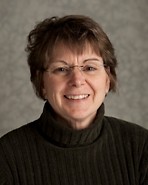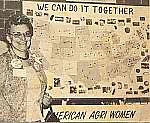Ahh . . . the spectacular spring blossoms of sweet-smelling apple, peach, cherry and other fruit trees will soon be in bloom along "The Ridge," the legendary area northwest of Grand Rapids known for its breathtaking rolling hills and prolific fruit trees.
Join us Thursday evening as local historian Cindy Laug explores the sometimes forgotten yet pivotal role women played in developing this world-renowned farming area. The free event, "Women of the Ridge: Handling the Business and Politics of West Michigan Agriculture," will be held at 7 p.m. Thursday, March 22 at the Gerald R. Ford Presidential Museum, 303 Pearl Street NW. The public is welcome and parking is free.
In commemoration of Women's History Month, the program is one of several events sponsored by the Greater Grand Rapids Women's History Council.
The Fruit Ridge area, known simply as "The Ridge," is one of the most abundant fruit-growing regions in the world because of its unique fertile soil, elevation, gentle rolling slopes, ideal climate and proximity to Lake Michigan. Located about 20 miles northwest of downtown Grand Rapids, "The Ridge" spans 158 square miles west of the Grand River and bordered by Bailey Road, Leonard Street and a line passing through Coopersville and Ravenna. Today, one in four jobs in Michigan relies on agriculture.
The tenacity and resourcefulness of numerous local women helped build this economic powerhouse that accounts for more than 60 percent of all Michigan apple production alone.
Laug, the Grand Valley State University administrative assistant for the College of Liberal Arts & Sciences, will talk about the determination these women displayed when they stepped away from their kitchens and orchards to support family farms in a political and marketing-savvy manner, particularly during the 1950s through the 1970s. They promoted their family's produce through smorgasbords, festivals, Apple Queen contests, tours, exhibits, recipes and more.
During the 1950s and 1960s, the annual invitation-only Apple Smorgasbord often drew up to 600 people, including former President Gerald R. Ford, former Michigan Governors George Romney and G. Mennen Williams, and grocery legend Fred Meijer. In the 1950s, the Apple Smorgasbord group relied on mostly German Swedish recipes for the buffet dishes that at one time received more than 4,000 requests for the recipes.
One year, the group even recruited former First Lady Betty Ford to be a judge at an apple smorgasbord and obtained a recipe from Lady Bird Johnson for her White House Apple Tarts. Covering the popular extravaganza were reporters from national publications such as the Washington Post Times, Good Housekeeping and Parents Magazine.
In 1972, the farm women became more political. They formed the Women for the Survival of Agriculture in Michigan to get on the ground floor of governmental decision-making in areas such as land use, taxes, pesticide use and more. Wearing white gloves, they organized "lady-like" picket lines outside local fruit processors who were underpaying apple farmers on The Ridge.
Among some of the honored guests Thursday evening will be Sharon Steffens and JoAnne Thome, two of the 1972 leaders known as the "Fearsome Foursome." Steffens was elected the first national coordinator of the American Agri Women organization, a coalition formed in 1974 of farm women and farm women's organizations. The Thome family name is well known on The Ridge as well for its successful farming enterprise.
Joining them will be Ginny Ebers who took over the reins of a local apple orchard following the sudden death of her husband, Rocky, in 1970. Pat Rasch Cederholm and her sister Mary Rasch Alt will also share their recollections of farm life along The Ridge.
Laug's exhaustive research on Women of the Ridge can be found at the Grand Rapids Historical Commission's virtual archive, a pioneering online collection of local historical materials.
What's your favorite fruit from the Ridge? Apples? Peaches? Cherries? The Ridge Economic Agricultural Partners (REAP) would like to know. Just for fun, take the REAP poll by clicking here. Then join us to learn more about the remarkable and sometimes forgotten story of Women on the Ridge!
The Rapidian, a program of the 501(c)3 nonprofit Community Media Center, relies on the community’s support to help cover the cost of training reporters and publishing content.
We need your help.
If each of our readers and content creators who values this community platform help support its creation and maintenance, The Rapidian can continue to educate and facilitate a conversation around issues for years to come.
Please support The Rapidian and make a contribution today.



